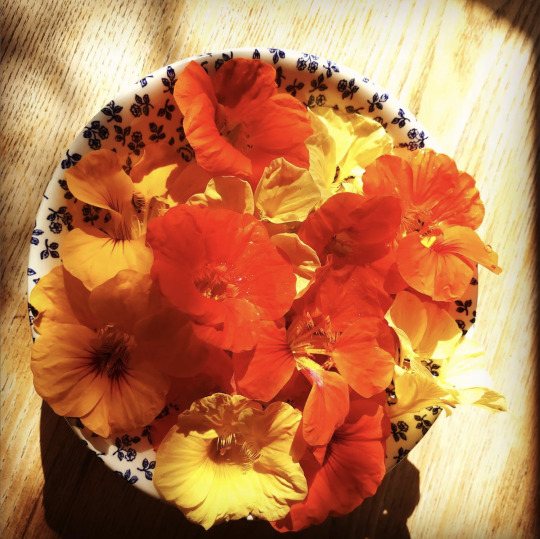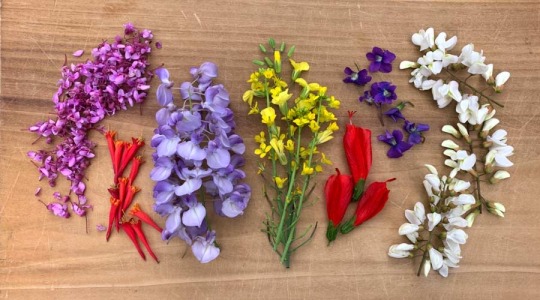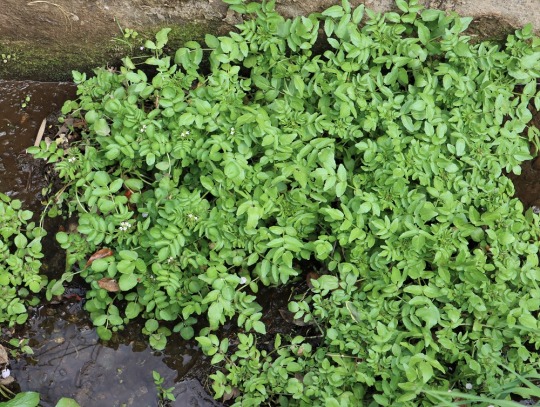#nasturtium officinale
Explore tagged Tumblr posts
Text

Sunlit Watercress
Watercress flowering in the afternoon sunlight, along the bank of the River Shep, at RSPB Fowlmere.
#cambridgeshire#canon#canonuk#flora#flower#flowers#fowlmere#nasturtium officinale#nature#nature reserve#outdoors#plant#plants#rspb#rspb fowlmere#watercress
8 notes
·
View notes
Text

種漬花[Tanetsukebana] Cardamine occulta
種[Tane] : Seed
漬[Tsuke] : To soak
花[-bana|Hana] : Flower
It is so named because these flowers bloom in spring around the time rice seed pods are soaked in water to make seedlings.
This is one of difficult species to distinguish from its many similar ones. I found this one on a rice field path, in a moist environment, and it had many cilia on the stem and stalks, no rhizomatous leaves could be found, and six stamens in the flower. For these reasons, I identified it in this way.
I sometimes hear people say, this is good to eat. I have never had one. It seems to taste like 和蘭辛子[Orandagarashi](lit. Holland mustard; we usually call it クレソン[Kureson], Nasturtium officinale). I guess they are similar because they both belong to the Brassicaceae family.
たねつけばな (途中より) まだ若い芽の中に採つたものは、刺身のつまなどに用ひて上乘、生のまゝ十分に口にすることが出來る、少しく辛味があつて味甚だ佳、煮てもうまく、根と葉と共にゆで靑い汁を去つて淸水で洗ひ淨め浸しものにし、又は二杯酢、胡麻和へにしてもよく、鹽漬にしても上品でよい。 一種おほたねつけばながある、この方は飯に炊き込むか、雜炊に入れるか、或はあげものが一番よい、すべてたねつけばなに似ているのであるが、葉が圓く、且つ大きい。
[Tanetsukebana] (Tochū yori) Mada wakai me no uchi ni totta mono wa, sashimi no tsuma nado ni mochiite jōjō, nama no mama jūbun ni kuchi ni suru koto ga dekiru. Sukoshiku karami ga atte aji hanahada ka. Nitemo umaku, ne to ha to tomo ni yude aoi shiru wo satte seisui de arai kiyome hitashimono ni shi, mata wa nihaizu, gomaae ni shitemo yoku, shiozuke ni shitemo jōhin de yoi. Isshu ootanetsukebana ga aru. Kono kata wa meshi ni takikomu ka, zōsui ni ireru ka, aruiwa agemono ga ichiban yoi. Subete tanetsukebana ni niteiru no dearu ga, ha ga maruku, katsu ookii.
[Hidden bittercress] (From the middle) Those collected while they are still young shoots are very good when used as a garnish for sashimi and other dishes, and can also be eaten raw. It has a slightly pungent taste and is very tasty. It is also good boiled, or boiled with the roots and leaves to remove the green juice, then rinsed in water and served as a hitashimono (o-hitashi, boiled greens in bonito-flavoured soy sauce), or as a nihai-zu(vinegar and soy sauce mixed in equal proportions) or a goma-ae(dish dressed with sesame sauce), or when pickled in salt, it has a refined. There is another species called Ootanetsukebana(C. dentipetala). This one is best cooked with rice, in porridge, or deep fried. Although it is almost similar to Tanetsukebana, the leaves are round and larger. From 芽の味覚[Me no mikaku](The taste of buds) by 金井 紫雲[Kanai Shiun](News and art reporter, 1888-1954) Source: https://dl.ndl.go.jp/pid/1065546/1/46
Usually I do not pick and eat feral plants that grow in the wild very aggressively. If I do, it is only to taste them a little. Exceptions are 蓬[Yomogi](Mugwort, Artemisia indica) growing as a weed in my field and rarely 木苺[Kiichigo](The genus Rubus), etc.
8 notes
·
View notes
Text

Nasturtiums are a prime example of how pseudo-scientific names can be extremely confusing. This fiery flower is called a Nasturtium, which most plant lovers assume is its scientific name. Guess again - the genus Nasturtium is in fact the genus of the watercresses, a different type of plant (Nasturtium microphyllum and Nasturtium officinale) that grows along brooks. So how did this pretty and tasty garden flower (Tropaeolum majus) end up being called “Nasturtium “ of all things? The answer is in the taste of the spicy leaves and flowers which are used as a easier to obtain substitute for real watercress.
#nasturtium#orangeflowers#edibleflowers#englishcottagegarden#saladflowers#plantnamessimplified
#katia plant scientist#botany#plant biology#plant science#plants#flowers#orange flowers#fire colours#nasturtium#tropaeolum#edible flowers#latin name#scientific names#botanical#botanical photography
46 notes
·
View notes
Text
Edible Wildflowers: A Forager's Guide for Uncertain Times
🌺🪷🌼🌸🥀💐🌹🌷

In a world where economic stability can sometimes feel uncertain, it's essential to explore alternative sources of sustenance. Wildflowers, often overlooked, offer a surprising and potentially life-saving solution. In this blog post, we'll delve into a comprehensive guide to edible wildflowers that can be found in all 50 states of the USA. Additionally, we've compiled a list of engaging books on the subject for our Gen Z readers who are eager to learn more.

**Edible Wildflowers Across America:**
Before we dive into the list, it's crucial to practice responsible foraging. Make sure you:
1. **Identify Properly:** Be 100% certain of a flower's identity before consuming it. Field guides and apps can be helpful for this.
2. **Avoid Polluted Areas:** Only forage in clean, uncontaminated areas, far from roadsides and industrial areas.
3. **Sustainability:** Harvest in moderation, so you don't harm the local ecosystem.
**Edible Wildflowers List:**
1. **Dandelion (Taraxacum officinale):** Found throughout the United States, dandelions offer edible leaves, flowers, and roots. They can be used in salads, teas, or as a root coffee substitute.
2. **Violet (Viola spp.):** These lovely purple flowers are not only edible but also high in vitamin C. They can be used in salads or candied for desserts.
3. **Clover (Trifolium spp.):** The blossoms of clover are sweet and can be nibbled directly or used in salads and teas.
4. **Nasturtium (Tropaeolum majus):** Known for their peppery flavor, nasturtium flowers are excellent additions to salads and sandwiches.
5. **Daylily (Hemerocallis spp.):** These striking flowers have edible petals and can be used in stir-fries or salads.
6. **Chicory (Cichorium intybus):** The petals of chicory flowers can add a slightly bitter flavor to salads or used as a garnish.
7. **Elderflower (Sambucus spp.):** Elderflowers make delightful fritters and are used to make elderflower cordial and wine.
8. **Sunflower (Helianthus spp.):** Sunflower petals are edible and can be used in salads or as a garnish.

**Recommended Reading:**
1. **"The Forager's Harvest" by Samuel Thayer:** This comprehensive guide covers edible wild plants, including wildflowers, and how to responsibly harvest them.
2. **"The Wildcrafting Brewer" by Pascal Baudar:** Explore the art of brewing with wild ingredients, including edible wildflowers, in this creative guide.
3. **"Backyard Foraging" by Ellen Zachos:** Perfect for urban foragers, this book focuses on finding edible plants, including wildflowers, close to home.
4. **"Foraging California" by Christopher Nyerges:** If you're on the West Coast, this guide will help you discover a wide range of edible wildflowers in California.

As we navigate uncertain times, learning about edible wildflowers can provide an essential skillset for self-sufficiency. Remember to approach foraging responsibly and sustainably, respecting the natural world. With the right knowledge and respect for nature, you can transform wildflowers into delightful additions to your diet. Happy foraging!
I hope you enjoyed this post. Find me on Youtube and X @diaryofpetals or email me at [email protected]
🍒🪷🌼🌹🌺💐🌸🥀🌷
#flowers#botany#garden#old orchard beach#wildflowers#flores#jardines#texto de amor#mis notas#virales#viralpost#viral video#viral trends#viralpage#colors
2 notes
·
View notes
Text
8 benefícios do agrião e 4 formas de consumo mais tradicionais
O agrião (Nasturtium officinale) é uma hortaliça de sabor levemente picante e repleta de benefícios para a saúde. Rico em nutrientes essenciais, ele pode ser incluído na alimentação de diversas formas, garantindo bem-estar e prevenção de doenças. Confira 8 benefícios do agrião para a saúde e 4 formas tradicionais de consumo. Os benefícios do agrião Fortalece o sistema imunológico: A hortaliça é…
0 notes
Text
#2694 - Xanthorhoe semifissata - Barred Pink Looper

Male.
First described by Francis Walker in 1862 as Cohemia semifissata. Since then it's been shuffled between Larentia, Helastia, and Xanthorhoe.
A Geometrid endemic to New Zealand, although much less common in the mountains in the west and south of the South Island. So finding it in Queenstown might be unusual. The caterpillar's hostplants include Nasturtium officinale as well as bittercresses (Cardamine sp.). Adult moths are found in shrubs at the edge of native forest.
Queenstown, Aotearoa New Zealand
0 notes
Text
Le cresson de fontaine


Culture du cresson de fontaine
présentation
Le cresson de fontaine est cultivé en France depuis Napoléon. On l'appelle aussi Nasturtium officinale qui est son nom scientifique. Il fait partie de la famille des Brassicacéees. Il est très facile à cultiver et son entretien est modéré. Son besoin en eau est très important. En fait, il s'agit d'une plante vivace aquatique voire semi-aquatique, d'où son besoin en eau important. Son feuillage est persistant. Ne le confondez pas avec le cresson alénois ni avec le cresson de jardin ou bien le cresson de para. Le cresson de fontaine se développe spontanément en Europe, en Afrique du Nord et en Asie. Sa hauteur à maturité et suivant l'espèce cultivée, est comprise entre 30 et 60 centimètres. BIENFAIT DU CRESSON DE FONTAINE SUR NOTRE SANTÉ Il est très riche en vitamines C, en provitamines A et B9. Il est également riche en lutéine (qui est un antioxydant). Le cresson de fontaine contient aussi de nombreux sels minéraux et il serait parait-il un excellent stimulant de l'appétit. D'autres parts, d'après des études il aurait un effet contre le cancer du colorectal et du poumon.
culture
Le cresson de fontaine se cultive en pleine terre inondable ou bien en bac. Choisissez-lui un emplacement à mi-ombre. Vous avez deux solutions pour le cultiver. Tout d'abord en terrine sous châssis ou bien sous mini-serre en mars/avril. La deuxième méthode consiste à le semer directement en pleine terre du mois de mai au mois de juillet. Pour un semis en terrine, remplissez cette dernière d'un mélange de tourbe et de compost que vous devez maintenir très humide. Le repiquage en pleine terre sur sol inondable ou bien en bac dans un substrat bien gorgé d'eau, se fait quand les jeunes plants possèdent 4 ou 5 feuilles. Autre solution : Choisissez dans votre jardin un endroit à mi-ombre. A la fin de la saison hivernale, creusez une espèce de fosse de 20 centimètres de profondeur. Tapissez cette dernière d'une bâche perforée afin de retenir au maximum l'infiltration de l'eau d'arrosage. Remplissez la fosse d'un mélange de terre de jardin et de compost bien décomposé à parts égales. La température idéale pour la germination du cresson de fontaine est d'une vingtaine de degrés minimum. Semez à une quinzaine de centimètres en tous sens. Recouvrez les graines de 5 millimètres à un centimètre au maximum. En règle générale, il faut compter 10 à 20 jours pour la levée. Si vous avez effectué le semis à la volée, éclaircissez ce dernier à 15 centimètres en tous sens. A noter que vous pouvez vous dispenser du semis en achetant des plants directement dans une jardinerie ou chez un pépiniériste. Le cresson de fontaine accepte d'être cultivé dans toutes les r��gions françaises. Si vous cultivez le cresson de fontaine dans de bonnes conditions, vous pouvez commencer votre première récolte au bout de 8 semaines. Le cresson de fontaine doit se consommer très rapidement car il se conserve très mal. Vous pouvez mettre les bottes dans l'eau pendant 2 jours mais pas plus. Le cresson de fontaine s'utilise soit en salade ou bien en accompagnement de viandes de préférence rôties. La soupe de poisson est très appréciée pendant la saison hivernale.
entretien
Maintenez votre semis très humide afin de favoriser la germination. Après repiquage des jeunes plants en bac ou bien en pleine terre, veillez également à ce que la terre ne se dessèche pas. Maintenez votre culture toujours humide. Pendant la saison hivernale, s'il est prévu de grosses gelées, vous pouvez couvrir votre culture de cresson de fontaine d'un voile d'hivernage. Pendant la saison estivale, couvrez votre culture d'un voile d'ombrage afin de ralentir la montée à fleurs.
parasites & maladies
En règle générale, le cresson de fontaine est très résistant aux parasites et aux maladies. Parfois les pucerons peuvent le coloniser et les limaces peuvent venir croquer les jeunes pousses.
multiplication
Le cresson de fontaine peut se multiplier par bouturage à la saison automnale. Pour cela, épandez au fond d'un bac un lit de sable sur 4 centimètres d'épaisseur. Ensuite versez un mélange à parts égales de bonne terre de jardin et de compost. Mouillez abondamment ce substrat de telle manière à le rendre boueux. Effectuez des mottes très humides avec 1/3 de terreau, 1/3 de terre de jardin et 1/3 de compost. Mélanger le tout. Ensuite, plantez les boutures dans les mottes très humides et compressées. Déposez ces dernières à l'intérieur du bac sur la boue. Installez le bac dans un endroit lumineux et hors gel. Patientez jusqu'à la saison printanière pour repiquer tout ce petit monde soit en pleine terre ou bien en bac hors période de gel.
association
Je ne vous conseille pas d'associer le cresson de fontaine à d'autres plantes afin de lui laisser suffisamment d'espace pour se développer dans de bonnes conditions. Et pour terminer, je vous propose cette vidéo de la chaine YouTube Rustica https://youtu.be/b5ZpoZZ3How Read the full article
0 notes
Text

Flowering Watercress
Watercress flowers and seedpods in the afternoon sunlight, at RSPB Ouse Fen.
#cambridgeshire#canon#canonuk#flora#flower#flowers#hanson#nasturtium officinale#nature#nature reserve#ouse fen#outdoors#plant#plants#quarry#rspb#rspb ouse fen#watercress
2 notes
·
View notes
Text
0 notes
Text
5 Reasons To Grow Nasturtiums & 10 Delicious Nasturtium Recipes
Nasturtiums are an extremely useful and attractive flowering plant that deserve a space in every garden. This is the common name for Tropaeolum – the only genus in the plant family Tropaeolaceae. These flowers gained their common name because of their similarity to watercress (Nasturtium officinale). As you will learn in this article, there are plenty of reasons to grow nasturtiums in your…

View On WordPress
0 notes
Text
The list at the link:
arugula (Eruca sativa) basket-of-gold (Aurinia saxatilis) bittercress (genus Cardamine) cabbage and relatives (genus Brassica) bok choy (Brassica rapa, variety chinensis) brown mustard (Brassica juncea) broccoli (Brassica oleracea, variety italica) Brussels sprouts (Brassica oleracea, variety gemmifera) cabbage (Brassica oleracea, variety capitata) cauliflower (Brassica oleracea, variety botrytis) collard (Brassica oleracea, variety acephala) kale (Brassica oleracea, variety acephala) kohlrabi (Brassica oleracea, variety gongylodes) napa cabbage (Brassica rapa, variety pekinensis) rape (Brassica napus, variety napus) rutabaga (Brassica napus, variety napobrassica) turnip (Brassica rapa, variety rapa) candytuft (genus Iberis) charlock (Sinapis arvensis) dame’s rocket (Hesperis matronalis) honesty (genus Lunaria) horseradish (Armoracia rusticana) Kerguelen cabbage (Pringlea antiscorbutica) pennycress (genus Thlaspi) peppergrass (genus Lepidium) maca (Lepidium meyenii) radish (Raphanus sativus) rock cress (genus Arabis) rocket (genus Sisymbrium) rose of Jericho (Anastatica hierochuntica) sea kale (Crambe maritima) sea rocket (genus Cakile) shepherd’s purse (Capsella bursa-pastoris) stock (genus Matthiola) stonecress (genus Aethionema) sweet alyssum (Lobularia maritima) thale cress (Arabidopsis thaliana) wallflower (genus Erysimum) wasabi (Eutrema japonicum) watercress (Nasturtium officinale) white mustard (Sinapis alba) whitlow grass (genus Draba) wild radish (Raphanus raphanistrum) winter cress (genus Barbarea) woad (Isatis tinctoria) yellow cress (genus Rorippa)
so it's a lot more than just cabbage
(granted, some of these are decorative plants/flowers and not, specifically, food)
Discussing foods in the cabbage family, found out there's a chemical in them that some people perceive as bitter and other people don't perceive at all, then found this paper about it
which leads with this anecdote
About 66 years ago, A. L. Fox, a Du Pont chemist, reported a startling accidental discovery (Anonymous 1931, Fox 1932). Boyd (1950) describes the event: Dr A. L. Fox had occasion to prepare a quantity of phenyl-thio-carbamide… As he was placing this compound in a bottle some of it was dispersed into the air as dust. Thereupon another occupant of the laboratory complained of the bitter taste of the dust. This surprised Fox, who being much closer to the scene of operations had of course inhaled more of the dust, but had perceived no taste. He was so positive that the stuff was tasteless that he went so far as to taste some of the crystals directly, finding them as tasteless as chalk. Nevertheless the other chemist was convinced the substance was bitter and was confirmed in this impression when he in turn tasted the crystals and found them to be intensely bitter. Naturally a lively argument arose. In an attempt to settle it, the two chemists called in various other laboratory workers, friends and other people with whom they could establish contact. Some people declared the substance was tasteless and some again found it bitter.
and then you start thinking about how many scientific discoveries happened because of what would now be considered unacceptably lax materials handling/exposure
224 notes
·
View notes
Photo

これはクレソンだと思うんだけど、フェンスの向こうなので取れない(4月8日)
5 notes
·
View notes
Photo

Cresson de aqua | Wendell Smith | Flickr (CC BY 2.0)
1 note
·
View note
Photo

Instead of growing it in a running chalk stream, you can also pop your watercress in a container filled with super absorbent polymer balls. If you use a glass vase this is also a very decorative way of growing it. If you add some liquid fertiliser when soaking the water pearls your plant will get nutrients too I think.
I’m trying this out though, in a few months I will be able to say if this is indeed a good idea or if it’s more in the category of amaryllis with waxed bulbs and cacti with straw flowers on little sticks pricked into them.
And once again, these balls are made for children to play with, so they are supposed to be non-toxic and safe. As is all super absorbent polymer supposed to be.
#watercress#plantblr#gardeners on tumblr#indoor gardening#grow your own salad greens#mine#super absorbent polymer#orbeez#grow your own#salad#salad greens#nasturtium officinale
52 notes
·
View notes
Photo

Nouveau projet: les drapeaux fleuris
Celui est composé (de haut en bas) :
Grande Capucine - Tropaeolum majus L.
Soucis officinal - Calendula officinalis L.
Arum tacheté - Arum maculatum L.
Guimauve officinale - Althaea Officinalis L.
Violette odorante - Viola odorata L.
--------------------------------------------------------------
*New projet : FlowerFlag
Nasturtium flower
Calendula
Spotted Arum
Althea
Sweet violet
#lesbian flag#myart#sketchbook#flowers#queer community#dessin#drapeau lesbien#monart#fleurs#communauté queer#draw#drawing
9 notes
·
View notes